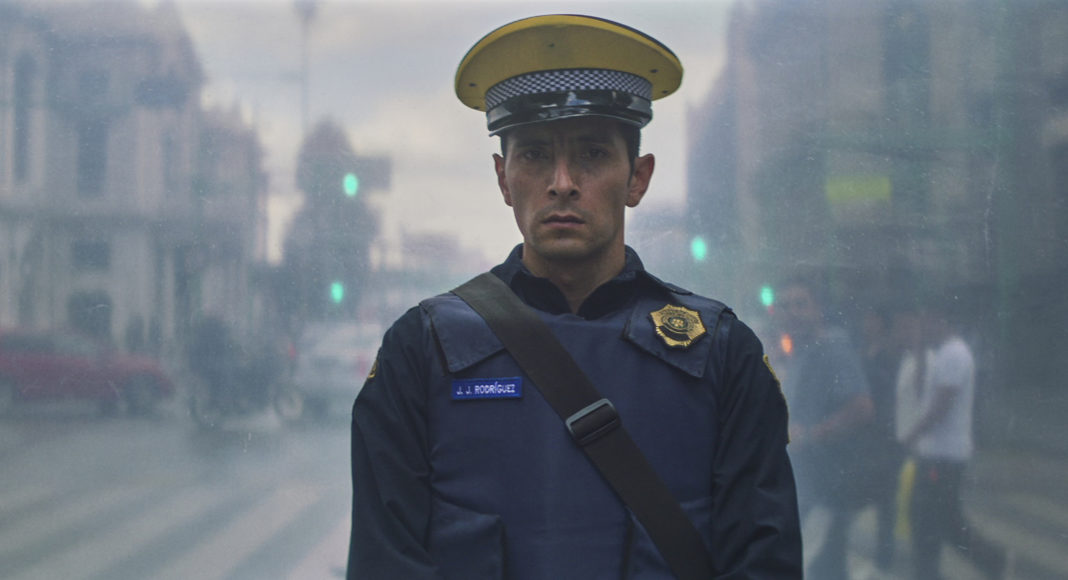The Mexican director and screenwriter behind ‘Güeros’ and ‘Museo’ returns to the big screen, this time zooming in on the people behind Mexico City’s disparaged police force.
Alonso Ruizpalacios’ latest feature film (now available on Netflix) opens to the sound of a sociocultural alarm bell – the police siren – against a backdrop of blurred blue and red strobes. We then watch as police officer Teresa helps a woman give birth. This poetic opening is just one of the ways in which the Mexican director defies expectations about the Mexico City Police in his unorthodox depiction of a controversial topic.
Blending documentary and dramatisation, the comically-titled A Cop Movie follows Teresa and Montoya, two real-life police officers whose stories are lip synced and re-enacted by two professional actors, Raúl Briones and Monica del Carmen.Through them, Ruizpalacios gets to the core of the force’s role in Mexico City society.
The past year and a half has seen a vast increase in awareness of police brutality worldwide, and the role of the police is something that we have reconsidered within our own local and national contexts. Ruizpalacios asks the same question but reframes it within the context of his hometown, his camera guiding us through the streets of Mexico’s capital city, and police stations and training academies, to find out who the individuals behind the uniform really are.
Reconsidering stereotypes
Mexico City’s police force drowns in negative stereotypes – most notably in reference to its high levels of corruption. But Ruizpalacios attempts to solidify, rupture and then reverse these stereotypes.
After Teresa asks a young yuppy hosting a warehouse party to turn down the volume for the neighbours, several notes are slipped into her hand as she is shooed away and a cup of beer is thrown onto her patrol car. Police officers may be corrupt, but citizens are also willing to pay into this system.
A similar atmosphere of mistrust is also perceived between police officers and their superiors. In many barrios, police chiefs turn a blind eye to threats, petty crimes, and larger robberies; unbeknownst to their subordinates. At one point in the film, Teresa finds herself in a precarious situation where she comes under fire for accidentally following up one of these loopholes.
A report by Poverty Action Lab analyses the unstable relationship: ‘Although Mexico City has one of the lowest homicide rates in the country, and has a largely effective police force, citizen perception of public safety and the reliability of the police force is consistently low,’ they attest, citing that ‘in 2017, 85 percent of Mexico City’s inhabitants reported feeling unsafe and only 37 percent reported having confidence in the police’.
Ruizpalacios seems to express that these levels of mistrust stem from both genuine corruption from those higher up in the force, as well the insecurity of the job. Whilst their slick uniform and position of relative power suggest a level of security higher than most wage earners, being a police officer in Mexico City is not a financially stable job.
Through the experiences of Teresa and Montoya, we learn that corruption often stems from necessity. After taxes, Teresa estimates that a police officer only has 1100 pesos (around $55 or £40) to live on per fortnight. Monica also surmises that 90% of female officers in Mexico City are single mothers.
Yet it is without condoning police corruption and abuse of power that Ruizpalacios brings these injustices to light, exposing the systemic problems which are near impossible to change, and in turn encouraging a reconception of the police.
Blending drama and reality
Casting actors and nonactors and blending reality and dramatisation also urges a deeper questioning of the role of the police. The viewer is granted a panoramic view of the institution through perspectives from both inside and outside the police community.
Part of the film takes place inside training academies where, undercover, both actors film their experiences from their phones. During this training process, Raúl reflects that ‘police officers are like actors’, suggesting a greater depth to their role than most of society assumes, and drawing attention to the performative aspect that the role requires. He importantly recognises his privilege as an actor in this situation, admitting that he can walk away at any point, not subject to the same discrimination and financial insecurities as real-life cops are.
Ruizpalacios is careful to not prioritise dramatisation over reality. The real Teresa and Montoya are introduced later on in the film, and it is clear from the deeply personal conversations and affection between the director and subjects that he has built a trusting relationship with them. In stark contrast to the mistrust that exists between the Mexico City police and citizens, and within the force itself, Ruizpalacios humanises police officers as normal people.
A microcosm of society
In some ways, Ruizpalacios represents the police force as a microcosm of wider CDMX society. Officers experience the same day-to-day challenges as many other chilangos (natives of Mexico City): racism, classism, machismo, corruption, violence. It is important to remember that they are just people in uniform, playing a role, and affected by the same socioeconomic issues as the rest of society. Ultimately, what A Cop Movie appears to say (through the lip synced mouthpieces of Raúl and Monica) is that whilst systemic change is necessary in policing, social change is necessary to improve the relationships between Mexico City’s police and citizens – of all social classes.
A Cop Movie is available to watch online now.


